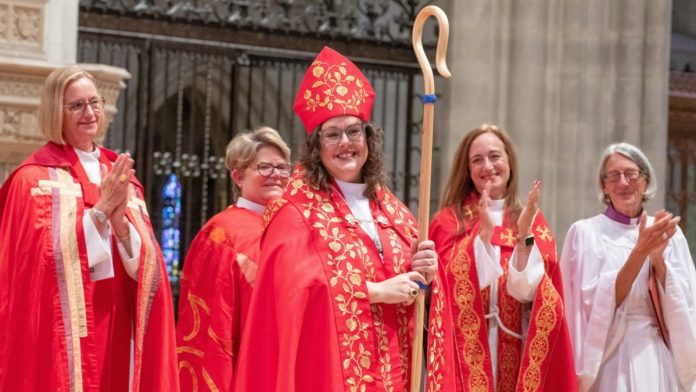The Rt. Rev. Carrie Schofield-Broadbent was ordained and consecrated as bishop coadjutor of the Diocese of Maryland on Saturday, Sept. 16 at Washington National Cathedral. She will become the 15th bishop of Maryland when the Rt. Rev. Eugene Taylor Sutton steps down as bishop diocesan in late spring 2024.
The Rt. Rev. Mary Gray-Reeves, vice president of the House of Bishops and managing director of the College for Bishops, was the chief consecrator. Joining Gray-Reeves as co-consecrators were Sutton; the Rt. Rev. DeDe Duncan-Probe, bishop of Central New York; the Rt. Rev. Chilton Knudsen, bishop of Maine, resigned; the Rt. Rev. Anne Bryson Jolly, bishop coadjutor of Ohio; the Rt. Rev. Frank Logue, bishop of Georgia; the Rev. William J. Gohl, Jr, bishop, Delaware-Maryland Synod, ELCA; and the Rt. Rev. M. Blair Couch, bishop of the Northern Province, Moravian Church in America.
Attending to his health at home, Presiding Bishop Michael Bruce Curry participated online. The service was livestreamed through Washington National Cathedral’s YouTube channel and the Diocese of Maryland’s website.
Schofield-Broadbent has served as a priest since 2003, most recently as canon to the ordinary for transition and leadership in the Episcopal Diocese of Central New York. She is committed to honoring the dignity of every human being, and consistently attends to her own work around race, climate change, economic justice and the full-inclusion of LGBTQ+ people in the life of the church. And she is committed to helping The Episcopal Church grow in these areas. Her consecration represents a significant step in furthering the Episcopal Diocese of Maryland’s commitment to inclusive leadership and fostering a vibrant, diverse and welcoming faith community.
Upon her consecration, Schofield-Broadbent said, “We’ve seen church attendance rise and fall across U.S. history. Sometimes it’s fashionable; sometimes it’s needed. Sometimes people are finding God in other places. I do think when people look at the Church today, too many look back to the way things were in the 1950s and ‘60s and say, ‘We were so much bigger then; we had to set up chairs in the aisles.’ I also know those churches didn’t always do the justice work we needed. They didn’t always form disciples. Some people showed up because it was weird not to. Having a nimble church, a faithful church, churches where people are committed to being there — I’m excited to see what that can look like.”
The full service is available to view here.










